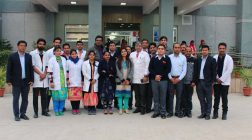India has one government hospital bed for 879 people on average, a ratio that starts looking nearly 10 times as bad in a state like Bihar, but improves dramatically in Manipur. Andhra Pradesh, where every tenth Indian student of medicine studies, has a government hospital bed for every 2,230 people.
India has one government hospital bed for 879 people on average, a ratio that starts looking nearly 10 times as bad in a state like Bihar, but improves dramatically in Manipur.
Andhra Pradesh, where every tenth Indian student of medicine studies, has a government hospital bed for every 2,230 people.
The estimates for January 1, 2013 were given to Lok Sabha by Health Minister Ghulam Nabi Azad Friday. As per the goals of the 12th Plan, India needs another 5,96,589 hospital beds to reach the target of 500 beds per 10,00,000 people.
A large chunk of Mumbai’s poor and lower-income category citizens is spending a good portion of income on healthcare by opting for relatively more expensive facilities at private or charitable clinics/hospitals over public services, according to the findings of a white paper on health published by Praja, a non-government organisation (NGO).
The NGO’s data on the “state of health of Mumbai” reveals that 58 per cent of those belonging to socio-economic classification or SEC C, 65 per cent from SEC D and 46 per cent from SEC E have preferred private services over government dispensaries/hospitals. The data is striking as a similar percentage from the upper strata of the society — the SEC A and SEC B — too turn to private services in Mumbai.
Only about a third of the city’s population relies only on government-based healthcare facilities. Across socio-economic strata, a mere 31 per cent of the population depends on government dispensaries and hospitals, 62 per cent goes to only private or charitable clinics and hospitals, while seven per cent uses both private and government health services.
Dr Amit Jadhav from Bombay Hospital said quality suffers as doctors are allowed to practice in public hospitals and privately, too. “Very few provide adequate healthcare services in public centres, thereby forcing their patients to end up in their (private) clinics. Even patients have more faith in private hospitals and clinics in comparison to public ones,” he said.
Padma Deosthali from the Centre for Enquiry Into Health and Allied Themes (CEHAT), a research centre working on health advocacy, said public primary healthcare is almost non-existent, forcing those from lower-middle and middle class to opt for private services. “The ward-level health posts and maternity homes of the municipal corporation in Mumbai are in a bad state. At the secondary and tertiary level of healthcare, people have to deal with the apathetic attitude of government hospitals where referrals are slow and user fee is still being charged. So, instead of saying that the economically weak sections are opting for private healthcare, the truth is that they are being pushed out to these,” she said.
Dr Gustad Daver, medical director at Hurkisondas Nurrotumdas Hospital & Research Centre, however, said if 31 per cent is availing government healthcare services, it is still a “fairly large” number. “For diseases such as dengue, malaria and diabetes, people generally consult their neighbourhood private clinic; if it is a complicated surgery or an ailment like cancer, people seek multiple opinions,” he said.
Dependency on non-government healthcare facilities is the highest for ailments like cancer and diabetes with 78 per cent cancer and 71 per cent diabetes patients choosing private or charitable hospitals. Further, 56 per cent of those suffering from malaria turn to private facilities, while 52 per cent with dengue opt for the same.
While the number of malaria cases has sharply declined in Mumbai, that of dengue has shot up. Dependency on government hospitals for malaria and dengue is 36 per cent and 31 percent respectively, higher than diabetes and cancer, in which 23 per cent and 13 per cent respectively seem to have faith in government services.
According to Dr Shubhangi Parkar, head of academics at KEM hospital, economically backward sections are apprehensive about getting treated in public healthcare centres due to the massive number of patients coming in daily. “I have seen cases where poor people go to private doctors for consultations because public hospitals are crowded. But they end up in public hospitals for treatment. They get diagnosed by private doctors, but since they cannot afford the private fees, they opt for treatment in public centres,” she said.
The study reveals that households spending over six per cent of their annual income on hospital or medical costs are maximum or 59 per cent in the lowest socio-economic strata or SEC E, followed by 56 per cent from SEC C, SEC D (54 per cent), SEC B (54 per cent) and SEC A (53 per cent). The figures are similar when we compare households spending over 11 per cent of their total annual income on medical or hospital costs — 17 per cent for SEC E, 18 per cent for SEC A, B and C and 15 per cent for SEC D. On an average, the lowest socio-economic strata spends 7.6 per cent of total income on healthcare, more than the most affluent that spends 7.1 per cent.
Additional municipal commissioner Manisha Mhaiskar, however, said civic hospitals cater to lower income groups and poor people usually prefer coming to public hospitals for treatment.
While inaugurating a 20-bed hospital in a village in Naini, Congress vice-president Rahul Gandhi on Monday stressed on the need for proper healthcare for the poor in rural areas.
The activists of the Bharatiya Janata Yuva Morcha (BJYM), the youth wing of the BJP, meanwhile, showed black flags to Gandhi’s cavalcade.
By evening, two BJYM activists were taken into preventive custody following their attempt to stage protest outside the Gobind Ballabh Social Science Institute (GBPSSI) at Jhunsi, where Gandhi had gone to attend a seminar on tribal issues.
After the inauguration of the hospital in Newada Samogarh village in Naini, Gandhi said that not getting medical health facilities is one reason why the poor in rural areas continue to remain poor. He told the gathering that the doctors preferred to work in swanky hospitals in big cities and avoid coming to rural areas. On the other hand, the poor could not afford the costly healthcare, which leaves us with a need to develop better healthcare facilities in rural areas, he said.
In his second visit to the institute, accompanied by state Congress president Nirmal Khatri and All-India Congress Committee’s UP in-charge Madhusudhan Mistry, Gandhi talked to intellectuals and tribal leaders of grassroot level on the issue of providing political space to the people from the most marginalised scheduled tribes and ensure their participation in the development process.

On Gandhi’s way back to Bamrauli, two BJYM workers, O P Dwivedi and Pintu Mishra, tried to get close to the cavalcade but were taken into preventive custody, while other BJYM activists clashed with Congress workers.
This goal is far below the world average of 30 hospital beds per 10,000 population, but above the World Health Organisation recommendation of 1.9 beds per 1,000 population.
The report of the high level expert group of the Planning Commission headed by Dr K S Reddy which was released in 2011 noted that of the 1.37 million hospital beds available in the country, 8,33,000 were in the private sector. India spends a little over 4 per cent of its GDP on healthcare, but the bulk of it comprises pocket expenditure.
Azad said that public health is a state subject. Under the National Rural Health Mission, the central government provides financial support to states to strengthen their health systems including new constructions and upgradation of public health facilities based on the requirement. Central government has decided to open eight new AIIMSes, and to upgrade 19 medical colleges and institutions to provide tertiery healthcare services that would add about 11,390 additional beds.
A recent report of the Indian Institute of Health Care and Informatics titled ‘Understanding Healthcare Access in India’ reported that nearly three of every four hospital beds in the country were in private, urban hospitals, a reality that forced the government’s hand on including public-private partnerships as one of the modalities of the National Health Mission in urban areas.
Given the shortcomings of the public health system, a large, mostly unorganised poorly regulated private sector has stepped in to fulfill unmet health needs. An appallingly large number of healthcare providers and facilities from the private and unorganised sectors are exploiting the lack of regulatory mechanisms and causing poor health outcomes, says the Plan panel report.
The health ministry’s efforts to push through a uniform Clinical Establishments Regulation Act has been only partially successful with just a handful of states – Arunachal Pradesh, Himachal Pradesh, Mizoram, Sikkim, Uttar Pradesh, Rajasthan and Jharkhand implementing it, apart from union territories. States like West Bengal have cited their own laws to stay out of the net.










